
Larches are deciduous conifers in the genus Larix, of the family Pinaceae. Growing from 20 to 45 metres tall, they are native to much of the cooler temperate northern hemisphere, on lowlands in the north and high on mountains further south. Larches are among the dominant plants in the boreal forests of Siberia and Canada. Although they are conifers, larches are deciduous trees that lose their needles in the autumn.
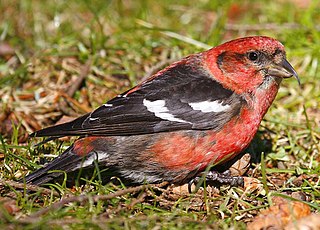
The two-barred crossbill or white-winged crossbill is a small passerine bird in the finch family Fringillidae.
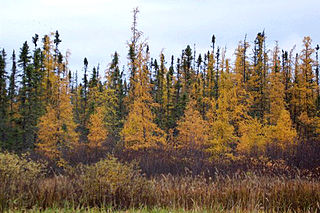
Larix laricina, commonly known as the tamarack, hackmatack, eastern larch, black larch, red larch, or American larch, is a species of larch native to Canada, from eastern Yukon and Inuvik, Northwest Territories east to Newfoundland, and also south into the upper northeastern United States from Minnesota to Cranesville Swamp, West Virginia; there is also an isolated population in central Alaska. The word akemantak is an Algonquian name for the species and means "wood used for snowshoes".

The common emerald is a moth of the family Geometridae. The species is found throughout the Nearctic and Palearctic regions and the Near East. It is mostly commonly found in the southern half of the British Isles. It was accidentally introduced into southern British Columbia in 1973.

Larix decidua, the European larch, is a species of larch native to the mountains of central Europe, in the Alps and Carpathian Mountains as well as the Pyrenees, with disjunct lowland populations in northern Poland and southern Lithuania. It is widely naturalized in Scandinavia. Its life span has been confirmed to be close to 1000 years but is more often around 200 years. It is claimed that one of the larches planted by the second Duke of Atholl at Dunkeld in 1738 is still standing.

The Lasiocampidae are a family of moths also known as eggars, snout moths, or lappet moths. Over 2,000 species occur worldwide, and probably not all have been named or studied.

The western larch is a species of larch native to the mountains of western North America ; in Canada in southeastern British Columbia and southwestern Alberta, and in the United States in eastern Washington, eastern Oregon, northern Idaho, and western Montana. It is the most productive of the three species of larch native to North America.

Larix gmelinii, the Dahurian larch or Gmelin larch, is a species of larch native to eastern Siberia and adjacent northeastern Mongolia, northeastern China (Heilongjiang), South Korea and North Korea.
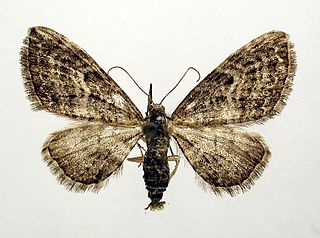
The larch pug is a moth of the family Geometridae. The species can be found in Europe, the Ural Mountains, West and Central Siberia, the Altai Mountains, Transbaikalia, Yakutia, the Far East, Mongolia, Korea, Japan and in North America, from Yukon and Newfoundland to New York and Arizona.

Dicallomera fascelina, the dark tussock, is a moth in the family Erebidae. The species was first described by Carl Linnaeus in his 1758 10th edition of Systema Naturae. It is found in most of Europe, through the Palearctic to Central Asia to Korea.
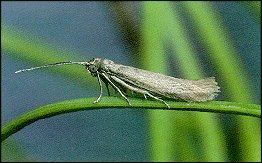
Coleophora laricella, the western larch case-bearer, is a moth belonging to the family of case-bearing moths Coleophoridae. It is native to Central and Northern Europe, with its original food source being the European larch or Larix decidua. However, it was introduced to North America in the mid-19th century where it has gained a wide range and become an invasive defoliater of several species of the genus Larix, particularly the western larch Larix occidentalis and the tamarack larch Larix laricina.

Zeiraphera improbana, the larch needleworm moth, is a moth of the family Tortricidae. It is found in North America.

Scolytus is a genus of bark beetles. It includes several species notorious for destroying trees in the forests. The Dutch elm disease is spread in North America by two species : the native elm bark beetle, Hylurgopinus rufipes, and the European elm bark beetle, Scolytus multistriatus. In Europe, while the aforementioned Scolytus multistriatus again acts as vector for infection, it is much less effective than the large elm bark beetle Scolytus scolytus.

Ditula angustiorana, the red-barred tortrix, is a moth of the family Tortricidae found in Africa, Asia, Europe and North Africa. Other common names are the fruit-tree tortrix and the vine tortrix. The moth was first described by Adrian Hardy Haworth in 1811.
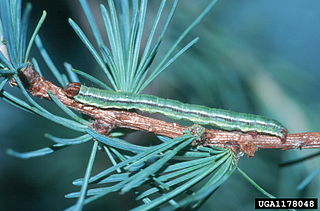
Macaria oweni, Owen's larch looper or Owen's angle moth, is a moth of the family Geometridae. The species was first described by Louis W. Swett in 1907. It is found in North America from Newfoundland to west-central Alberta, south in the east to northern New England.

The orange larch tubemaker is a moth of the family Gelechiidae. It is found in the north-eastern parts of the United States, as well as Canada.
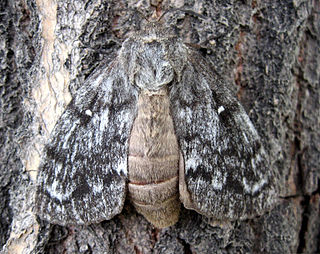
Dendrolimus superans, also called the white-lined silk moth, Sakhalin silk moth, Japanese hemlock caterpillar, Siberian silk moth, Siberian moth, Siberian conifer silk moth, Siberian lasiocampid or larch caterpillar, is a moth of the family Lasiocampidae.
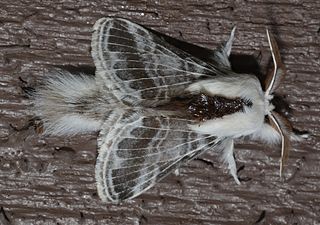
Tolype velleda, the large tolype moth or velleda lappet moth, is a species of moth of the family Lasiocampidae. It was first described by Caspar Stoll in 1791. The species is found from Nova Scotia to central Florida, west to Texas and north to Ontario.
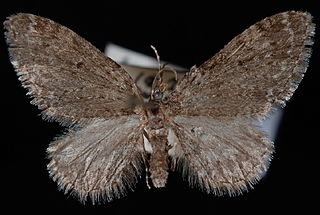
Eupithecia annulata, the larch pug moth, is a moth in the family Geometridae. The species was first described by George Duryea Hulst in 1896. It is found in North America from British Columbia north to the Yukon, east to Newfoundland and Labrador and south to California and Colorado.



















